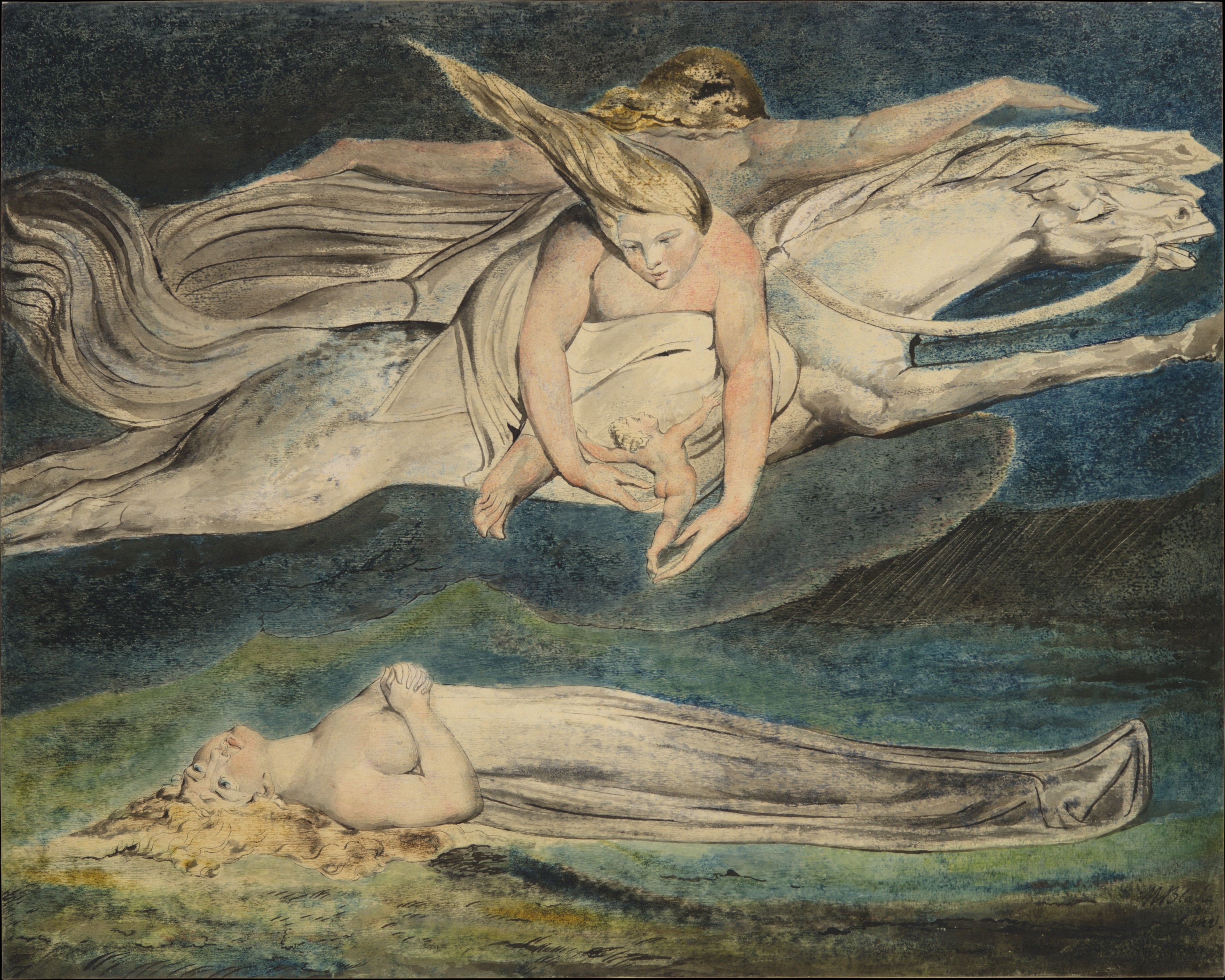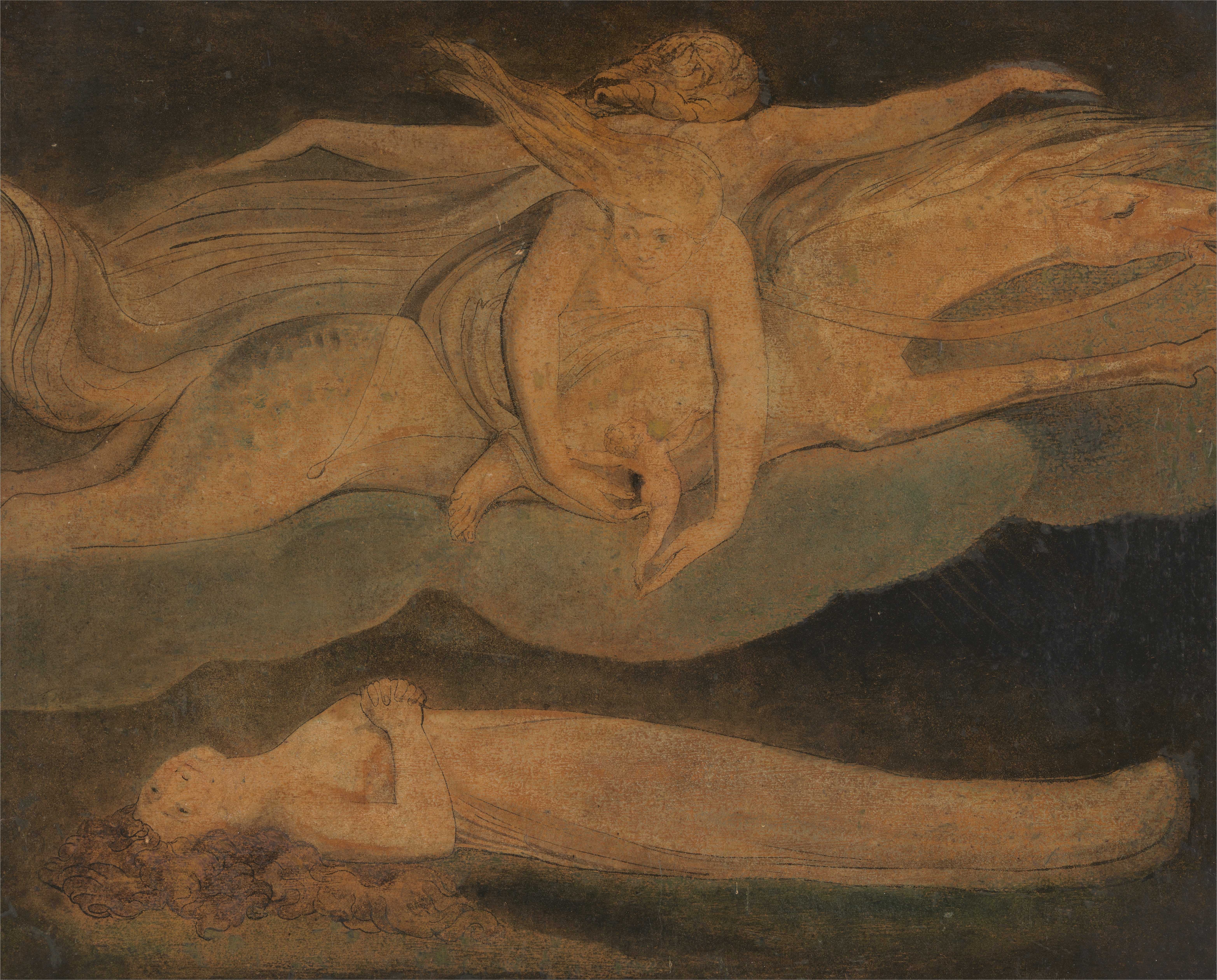Pity (William Blake) on:
[Wikipedia]
[Google]
[Amazon]
 ''Pity'' (c. 1795) is a colour print on paper, finished in ink and
''Pity'' (c. 1795) is a colour print on paper, finished in ink and
 The print exists in four versions from two different matrices. The most elaborate and best-known version of the print is in the Tate Gallery,
The print exists in four versions from two different matrices. The most elaborate and best-known version of the print is in the Tate Gallery, Morris Eaves, Robert Essick, Joseph Viscomi, et al The William Blake Archive
/ref>
''Pity'' by William Blake
Page on Tate Gallery official website.
Tate Learning
Artists in Focus: William Blake on Tate's official website. {{Macbeth Works by William Blake William Blake's mythology Romantic paintings 1795 prints Collection of the Tate galleries Prints and drawings in the British Museum Paintings in the Metropolitan Museum of Art Watercolor paintings Paintings based on works by William Shakespeare Works based on Macbeth Monotype prints
 ''Pity'' (c. 1795) is a colour print on paper, finished in ink and
''Pity'' (c. 1795) is a colour print on paper, finished in ink and watercolour
Watercolor (American English) or watercolour ( Commonwealth English; see spelling differences), also ''aquarelle'' (; from Italian diminutive of Latin 'water'), is a painting method"Watercolor may be as old as art itself, going back to the ...
, by the English artist and poet William Blake
William Blake (28 November 1757 – 12 August 1827) was an English poet, painter, and printmaker. Largely unrecognised during his life, Blake has become a seminal figure in the history of the Romantic poetry, poetry and visual art of the Roma ...
, one of the group known as the "Large Colour Prints". Along with his other works of this period, it was influenced by the Bible
The Bible is a collection of religious texts that are central to Christianity and Judaism, and esteemed in other Abrahamic religions such as Islam. The Bible is an anthology (a compilation of texts of a variety of forms) originally writt ...
, Milton, and Shakespeare
William Shakespeare ( 23 April 1564 – 23 April 1616) was an English playwright, poet and actor. He is widely regarded as the greatest writer in the English language and the world's pre-eminent dramatist. He is often called England's natio ...
. The work is unusual, as it is a literal illustration of a double simile from ''Macbeth
''The Tragedy of Macbeth'', often shortened to ''Macbeth'' (), is a tragedy by William Shakespeare, estimated to have been first performed in 1606. It dramatises the physically violent and damaging psychological effects of political ambiti ...
'', found in the lines:
: And pity, like a naked new-born babe,
: Striding the blast, or heaven's cherubim, horsed
: Upon the sightless couriers of the air.
:- ''Macbeth'' (1.7.21–23)
Like other members of the group, it is a monotype
Monotyping is a type of printmaking made by drawing or painting on a smooth, non-absorbent surface. The surface, or matrix, was historically a copper etching plate, but in contemporary work it can vary from zinc or glass to acrylic glass. The ...
produced by printing from a matrix consisting of paint on gesso
A restored gesso panel representing St. Martin of Tours, from St. Michael and All Angels Church, Lyndhurst, Hampshire
Gesso (; 'chalk', from the , from ), also known as "glue gesso" or "Italian gesso", is a white paint mixture used to coat rigi ...
ed millboard, with each impression then finished by hand. Blake could obtain up to three impressions from a single painting by this unusual means. Three such impressions survive of ''Pity''. A fourth, in the British Museum
The British Museum is a Museum, public museum dedicated to human history, art and culture located in the Bloomsbury area of London. Its permanent collection of eight million works is the largest in the world. It documents the story of human cu ...
, was an early trial of the design from a different matrix, as it is smaller than the others.
Interpretations
Martin Butlin wrote that this colour print is one of the most inspired of all 'literal' illustrations of a text in thehistory of art
The history of art focuses on objects made by humans for any number of spiritual, narrative, philosophical, symbolic, conceptual, documentary, decorative, and even functional and other purposes, but with a primary emphasis on its aesthetics ...
. In fact, "pity
Pity is a sympathetic sorrow evoked by the suffering of others. The word is comparable to ''compassion'', '' condolence'', or ''empathy''. It derives from the Latin (etymon also of ''piety''). Self-pity is pity directed towards oneself.
Two d ...
and air", two words of Shakespeare's verses, are also two motifs used by Blake in this picture: a female cherub leans down to snatch the baby from its mother. According to Blake's biographer Alexander Gilchrist, the print "is on a tolerably large scale, a woman bending down to succour a man stretched out at length as if given over to death."
''Pity'' is seen as in opposition to Blake's print '' The Night of Enitharmon's Joy'' (c. 1795) — which shows a Hecate surrounded by fantastic creatures and macabre elements of a nightmare — because it provides a "possibility of salvation
Salvation (from Latin: ''salvatio'', from ''salva'', 'safe, saved') is the state of being saved or protected from harm or a dire situation. In religion and theology, ''salvation'' generally refers to the deliverance of the soul from sin and its c ...
" in the fallen world through pity. Both prints refer to ''Macbeth''. As Nicholas Rawlinson has noted, the play was undergoing a major revival in popularity at the time, being performed nine times in 1795.
It is a personification
Personification is the representation of a thing or abstraction as a person, often as an embodiment or incarnation. In the arts, many things are commonly personified, including: places, especially cities, National personification, countries, an ...
of a Christian
A Christian () is a person who follows or adheres to Christianity, a Monotheism, monotheistic Abrahamic religion based on the life and teachings of Jesus in Christianity, Jesus Christ. Christians form the largest religious community in the wo ...
element that some critics argue was a negative virtue
A virtue () is a trait of excellence, including traits that may be morality, moral, social, or intellectual. The cultivation and refinement of virtue is held to be the "good of humanity" and thus is Value (ethics), valued as an Telos, end purpos ...
for Blake, since pity is associated with "the failure of inspiration and a further dividing" and also "linked by alliteration and capitalization". It is also a part of Blake's mythology, in which a sexually frustrated Tharmas becomes "a terror to all living things", although the emotion inherent in him is a pity. Other Blake characters have this feeling, and his mythology is developed between the confrontation of a feminine
Femininity (also called womanliness) is a set of attributes, behaviors, and Gender roles, roles generally associated with women and girls. Femininity can be understood as Social construction of gender, socially constructed, and there is also s ...
"Pity" and a masculine
Masculinity (also called manhood or manliness) is a set of attributes, behaviors, and roles generally associated with men and boys. Masculinity can be theoretically understood as socially constructed, and there is also evidence that some beh ...
fiery, as happens in the brutal suppression of desire in Urizen.
Some critics see a connection between ''Pity'' and the "hypnotic and helpless state" of William Butler Yeats
William Butler Yeats (, 13 June 186528 January 1939), popularly known as W. B. Yeats, was an Irish poet, dramatist, writer, and literary critic who was one of the foremost figures of 20th century in literature, 20th-century literature. He was ...
' '' The Wind Among the Reeds'' (1899).
Versions
 The print exists in four versions from two different matrices. The most elaborate and best-known version of the print is in the Tate Gallery,
The print exists in four versions from two different matrices. The most elaborate and best-known version of the print is in the Tate Gallery, London
London is the Capital city, capital and List of urban areas in the United Kingdom, largest city of both England and the United Kingdom, with a population of in . London metropolitan area, Its wider metropolitan area is the largest in Wester ...
, sometimes described as the only finished one. It was presented by W. Graham Robertson to the gallery in 1939 and is catalogued as "Butlin 310".
A unique "proof print" is in the British Museum
The British Museum is a Museum, public museum dedicated to human history, art and culture located in the Bloomsbury area of London. Its permanent collection of eight million works is the largest in the world. It documents the story of human cu ...
(Butlin 313). It is "significantly smaller than the final version of the design" and depicts the supine figure "partially covered in vegetation" in the form of sweeping fronds of long grass.
Another version of the image is in the collection of the Metropolitan Museum of Art
The Metropolitan Museum of Art, colloquially referred to as the Met, is an Encyclopedic museum, encyclopedic art museum in New York City. By floor area, it is the List of largest museums, third-largest museum in the world and the List of larg ...
. This is not as elaborately worked as the Tate print. It was donated by Mrs. Robert W. Goelet in 1958.
A lightly retouched version at the Yale Center for British Art also exists, somewhat yellowed by varnish. According to The William Blake Archive, "The characteristics of the colour printing indicate that this impression is the first one printed from the larger matrix in 1795. The second impression in this printing is ''Pity'' in the Tate Collection (Butlin 310); the third impression is in the Metropolitan Museum of Art, New York (Butlin 311)."/ref>
References
External links
''Pity'' by William Blake
Page on Tate Gallery official website.
Tate Learning
Artists in Focus: William Blake on Tate's official website. {{Macbeth Works by William Blake William Blake's mythology Romantic paintings 1795 prints Collection of the Tate galleries Prints and drawings in the British Museum Paintings in the Metropolitan Museum of Art Watercolor paintings Paintings based on works by William Shakespeare Works based on Macbeth Monotype prints